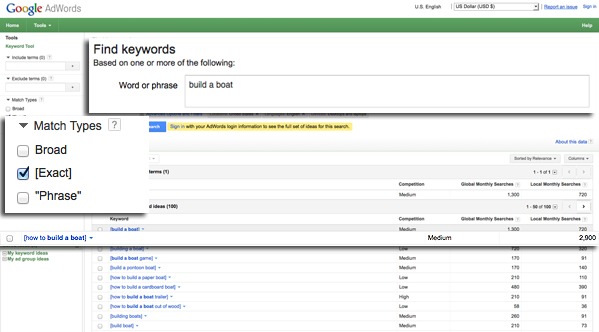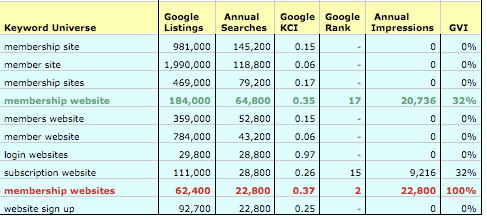
It might be true that some sites are “winning” the search engines simply by existing and being well-known reputable sources, like the New York Times or Wall Street Journal.
But it’s even more true that most of us have to work at it.
Don calls SEO “the new direct mail.” Keyword research and implementation are perhaps the most complex, yet effective ways to drive more search traffic to your website. The basic strategy of good SEO is that you can research your keywords, optimize your content, track your progress, and then repeat the whole process.
SEO success isn’t entirely dependent on keyword research though. It also involves good content (the stuff people want to read), and link-building through social media and reputable sites. The days of blog comment link-building have gotten tough, but thankfully we have social media on our side!
To fully illustrate the whole SEO process, we came up with the above diagram, but here’s the breakdown:
Research
Keyword research starts in the Google Keyword Tool, which is a tool typically used for AdSense, but also helps us see which words and phrases people are using to search for our content. The process looks a little something like this:
- Visit the Google Keyword Tool
- Type a keyword into the tool — a word or phrase that the article you’re optimizing is about
- Select [exact] Match Type
- Hit “Submit”
- Find a good keyword in the list that has a high Global Monthly Search volume

[text_ad]
Benchmark
To find out if the keyword we’ve found is valuable, we head to Google.com and enter the keyword phase in quotes (exact match) and hit “search.”
When the results display, so will the number of competing pages. For a site with less than 10,000 visitors per month, we try to target keywords that have less than 100,000 competing pages. The more visitors you have per month, the more competitive keywords you can choose.
As you can see, the term we selected has more than two million competing pages.

In this case, since it’s so very competitive, we might go back to the keyword tool and try to pick another one.
When we go back and try another keyword phrase, we may find that it has much less search volume per month, but also has millions fewer competing pages, which means we can actually rank, possibly on page one! Since ranking on page one is so important to SEO, competition is something we favor.

From here, we calculate the Keyword Competitive Index. The KCI is your estimated annual search impressions (monthly average searches taken from the keyword tool, times 12 months) divided by the number of exact match search engine results (the competition).
In the above example, “build a pontoon boat” has 480 searches per month. Multiplied by 12 months in the year, there are 5760 searches per year. With 28,000 competing pages, as seen above, the calculation looks like this:
5760/28000 = .20
The “sweet spot” for your SEO efforts is often a keyword phrase with a high KCI. At Mequoda Daily, we generally consider any keyword phrase with a KCI of “.5” or better to be a high value, low-risk target. A keyword phrase with a KCI of .1 to .49 is a B-grade target. Anything with a lower KCI is not generally a reasonable target for us and most of our consulting clients unless the competition is under 50,000, which generally makes it a shoo-in for page-one ranking.
If the KCI is over a full number, like 1, that means there are more people searching for the keyword than there are pages competing for it. That’s what we call a “blockbuster keyword” and we like to save those goodies for Rapid Conversion Landing Pages.
Organize
This process is tedious for sure, and that’s why we developed a little something we call the Google Visibility Report for our clients. It’s a robust report of keywords, that are organized in “clusters,” which are often your website categories. For example, a cluster for “boats” might have 200 keywords in it.
The GVR includes more than just the keyword, competition and KCI numbers though. We also include where you rank for each keyword, and which free white papers are associated with each cluster, among hundreds of other useful indicators.
The organization of this process is for the benefit of editors and content creators. When your editors are writing stories, they can look to the GVR for guidance on topic ideas so they don’t have to repeat the first two steps every time they want to write an article.
Here’s an example of the most basic elements of a GVR (we have to save the really special data for our clients, don’t we?)

Create
We create articles and landing pages with SEO in mind, but we shouldn’t let SEO define them completely.
All great articles need a beginning, a middle and an end. They have to be easy to follow, have good grammar and stand out to the readers. They cannot epitomize content farms or contain regurgitated information.
And remember, when you create a unique contribution, ask yourself, “Have I added value to the world on this topic because I didn’t just say what everyone else has said?” If the answer is yes, you’re well on your way to producing great content.
From here, we try to add the keyword into the first paragraph and once or twice more within the article for a fair keyword density.
Post
Every article gets posted into your Content Management System, which has hopefully been optimized for SEO.
Before posting each article, we make sure:
- The title of the article includes the keyword, preferably at the beginning
- The title and description meta tags are filled out and include our keywords
- The perma-link includes our keywords (which happens automatically in WordPress if they’re already in your title)
- Add the targeted keyword to the “tags” field
Promote
After you publish the post, tweet it, add it to Facebook, email it, tell your friends and media outlets about it and ask them to comment on it in hopes of getting the ball rolling. Comments have an impact to both users and Google, and the Panda update made them even more valuable.
Every time a new comment is added to a post, Google is reminded of the post’s relevancy, as the new content added is typically by readers with helpful tips to add to the conversation.
Analyze
This brings us back to the GVR. We constantly keep tabs on our articles and keywords to see where they rank. You can also do it manually by Googling your keywords and seeing if they show up on page one.
We do this for thousands of keywords automatically with the tools that we use, but manually this would certainly get tedious. One free way to do this is to install a sometimes inaccurate but free WordPress plugin called SEO Rank Reporter.
Using this process, you can write every post with intention—to get ranked. And that’s not meant to sound markety, either. After all, when you’re spending as much time writing as bloggers do, don’t you want people to keep reading those articles days, months and years later? SEO is an amazing way to recycle content.


